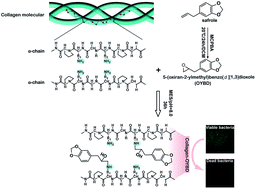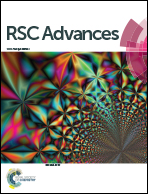Collagen modified with epoxidized safrole for improving antibacterial activity
Abstract
An epoxidized safrole, 5-(oxiran-2-ylmethyl)-benzo[d][1,3]dioxole (OYBD), was synthesized and employed to modify collagen for improving its antibacterial activity. The interaction between collagen and OYBD, and the structure/properties of the modified collagen were investigated in detail. The results indicated that the OYBD-modified collagen showed a higher de-nature temperature (Td, 90.2 °C), improved hydrophobic properties (contact angle from 84.2° to 89.1°) and enhanced tensile strength (6.2–11.0%) without destroying its triple helix structure. From observation of scanning electron microscopy (SEM), a higher density of intertwining morphology and a more stable network structure were observed, which was consistent with improved tensile strength and reduced breaking extension stress. The antibacterial test and LIVE/DEAD Baclight bacterial viability assay illustrated that the modified collagen exhibited excellent antibacterial activity to both Gram-negative and Gram-positive bacteria. Furthermore, the OYBD-modified collagen still exhibited cytocompatibility, supporting human fibroblast proliferation, which holds a great potential for developing antibacterial collagen-based biomaterials.



 Please wait while we load your content...
Please wait while we load your content...